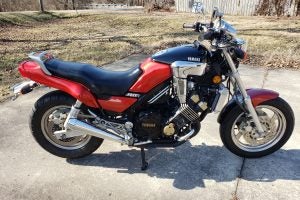Honda takes a lot of flack these days for being too boring, too cautious. While Big Red still has a reputation for mechanical excellence, and superb fit-and-finish, motojournos and hardcore riders moan about how the company’s bikes just aren’t as exciting as they used to be.
What’s going on? Maybe this is a problem of experienced motorcyclists simply getting too spoiled, and taking things like reliability for granted, and they need to stop whining. Or, maybe Honda just decided to play it cautious after getting burned on machines like the GB500 TT, a very cool bike that saw poor export sales.

That dry sump engine looks good in that vintage-styled bodywork! Photo: Cycle Trader
Cafe racer via Japan
The GB500 TT (usually referred to as the GB500) was an oddity when it debuted in the US in 1989. It was an homage to classic British motorcycles that had dominated the Isle of Man races in the mid-20th century, and the name made it obvious if the bodywork didn’t. GB = Great Britain, and the TT was for Tourist Trophy, from the Isle of Man TT races.
Back in the late ’80s, everyone wanted plasticky superbikes, not retro Brit bikes, so the Honda was weird. Mind you, the Japanese had done this sort of thing before; both Kawasaki and Yamaha had long had parallel twins in their lineup with strong visual resemblance to British-built bikes, and the KZ750 twin and XS650 were both often seen as sensible, reliable alternatives to finicky made-in-the-UK machines.
Nobody ever got too excited about British singles, though. Those thumpers were generally seen as rattly and antiquated, and nobody was interested in commemorating those machines and their successes (unless you count the Yamaha SR500, maybe). Even today, no major manufacturer builds a big-bore single-cylinder retro that looks like a vintage Brit bike.

A very clever re-purposing of Honda’s big-bore XR/XL engine into a totally different style of bike. Photo: Cycle Trader
- Clubman bars, and a lean profile that makes for a cafe racer image. Photo: Cycle Trader
- A 2-1 exhaust on a single? It was the ’80s, and Honda’s RFVC setup meant dual-pipe heads on singles. The times were strange. Photo: Cycle Trader
But, in the ’80s, Honda insiders must have had fond memories of the hairy-chested four-stroke British singles that once dominated TT racing, and they put the engineers to work. First, they built the GB250, a cafe-styled bike with a downsized engine taken from the XL350 dual sport. These machines are incredibly rare outside Japan, as they were never officially exported. Some examples made it to other countries through the gray market import scene, and were well-liked for their low-end torque.
Why didn’t Honda export the GB250 to other countries? Probably the same reason so many other 250 models never make it outside the Japanese domestic market: Executives don’t expect jaded, power-hungry buyers will pay a fair price for a bike that’s perceived as “too small.” At home in Japan, restrictive regulations make 250s attractive, but in Europe, Australia and North America, buyers want bigger machines.
That’s likely why Honda decided to instead bring the GB500 for introduction in western markets in 1989 (Japan and other countries saw it for sale earlier, and they also saw a 400 version). This bike was powered by an oversquare air-cooled 498 cc single, with four-valve RFVC head and single overhead cam. As it was adapted from the larger XL/XR 500-600 series, it had a dry sump design. It was rated for 39 horsepower at 6,500 rpm. That was still way behind the hot four-cylinders of the day, but it was enough for a competent rider to have a lot of fun on a back road.

Vintage dual shock setup means you shouldn’t expect superbike handling. Photo: Cycle Trader
With drum rear brake, single-disc front brake, dual rear shocks, telescopic front forks (including period-correct fork gaiters!) and spoked alloy 18-inch rims, the GB500 was hardly a technical masterpiece. The chassis and running gear were nicely matched to the engine, though, and the style of riding this bike was made for. Wet weight was 390 pounds, and the chassis came with short wheelbase and tight angles, for fast steering. You could still have a lot of fun on this bike in the corners, if you kept the engine on the boil.
Or, with that nice cafe-style seat and clubman bars, riders were able to tuck into an old-school crouch and grimly blast around town in search of caffeine and jukeboxes, pretending they were at the Ace Cafe, even if they were really headed for Dunkin’ Donuts. Some models even came with a cockpit fairing or two-up bench seat, for a ’60s look.
Honda generously included a kickstarter on the side of the engine, so you could stomp your bike to life and impress all viewers (or shamefacedly resort to the electric boot, if your quads weren’t up too the challenge).
But, there just wasn’t enough interest to keep sales going in North America. The US only saw the GB500 imported for 1989 and 1990, and then it disappeared from Honda’s lineup.

With 571 miles on the clocks, this bike has barely been ridden in the past 30 years. Photo: Cycle Trader
This bike here?
These days, it’s a different story. With a renewed interest in retro bikes, the rare-in-the-US GB500 now commands a fairly high resale value, especially if you find one in good shape, like this example in Boca Raton, Florida.
This is a 1990 model, and it looks to be in very good shape, with only 571 original miles on the odometer. Asking price is an astronomical $12,500, which is pretty high when you consider you can buy a much newer retro from Triumph or Royal Enfield for that cash, or less, and it will have ABS and EFI.
If you must have a GB500, though, you’ll have to pay. At least it’s a good excuse to go visit Florida?









